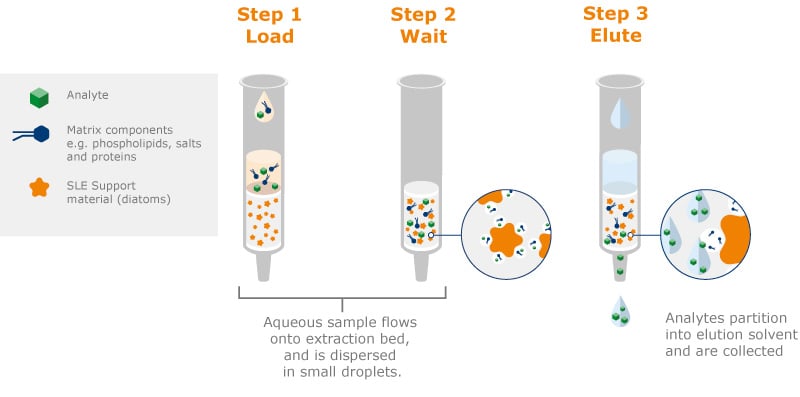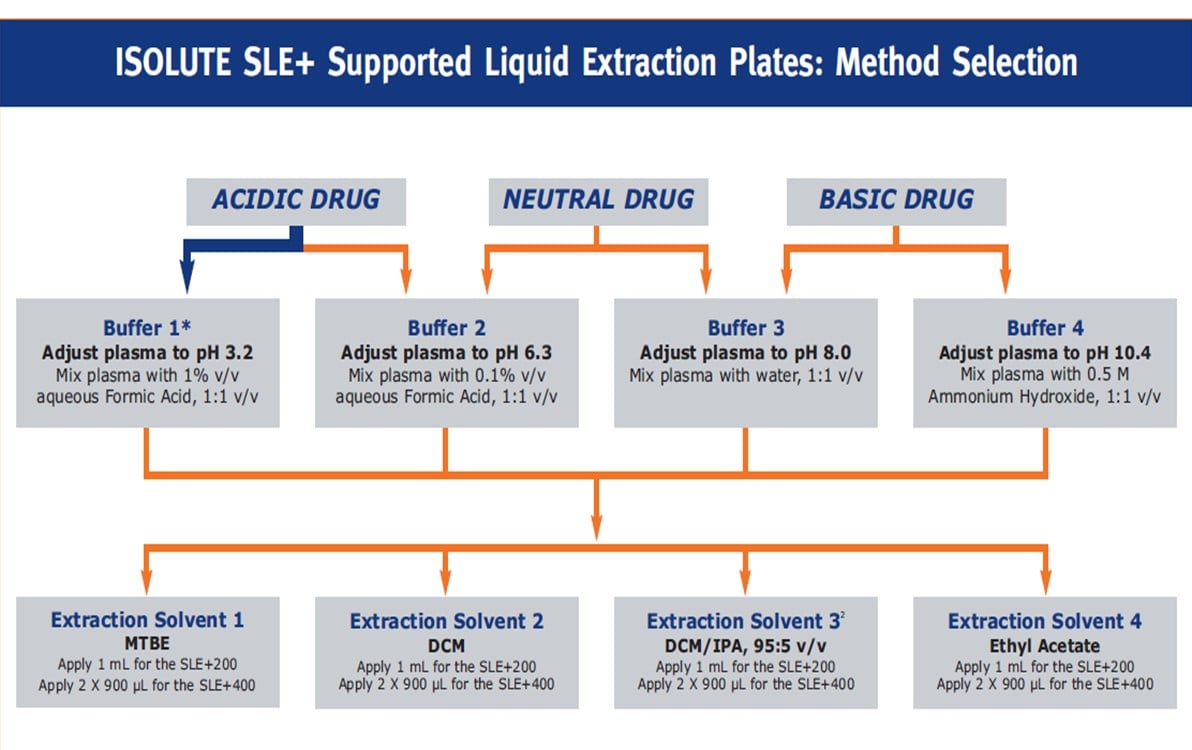Feb 2, 2023 4:39:25 PM
What’s the Best Way to do Supported Liquid Extraction?
By Stephanie J. Marin

Supported Liquid Extraction (SLE) is a sample preparation technique that has been in use for over ten years now, but many analytical chemists don’t know about, or understand the best way to do an SLE extraction. In this post, I’m going to talk about how SLE works and the proper way to do an SLE extraction for sample clean up.
SLE is similar to liquid-liquid extraction (LLE), but it’s done using a cartridge or 96 well plate. It does not form emulsions like LLE, and removes phospholipids, salts and proteins. Most samples that can be cleaned up using LLE can be processed using SLE. An aqueous sample is loaded onto a cartridge packed with the SLE extraction media. The Biotage ISOLUTE SLE+ is a refined, porous, highly purified diatomaceous earth. The sample is absorbed onto the solid and dispersed as small droplets. Next, a water immiscible solvent is added. Compounds partition into the organic phase just like LLE, except instead of vigorously shaking the sample to create small droplets for partitioning, the organic solvent easily flows through the SLE cartridge, interacting with the aqueous phase absorbed on the column. Here is a diagram outlining the steps in an SLE extraction:
 Interfering compounds remain absorbed on the SLE column. The octanol-water partition coefficient (logP) indicates how well an analyte will partition into the organic phase using SLE. Typical elution solvents used for SLE are dichloromethane, ethyl acetate, MTBE, or hexane, but any water immiscible organic solvent can be used. The higher the logP, the more easily the compound will partition into the organic phase. Compounds with a logP of 1 or lower may need acid or base pretreatment to suppress ionization of compounds, or the addition of a modifier like 2-propanol or acetonitrile to the extraction solvent to recover more hydrophilic compounds. Don’t add more than 5-10% 2-propanol or about 2% acetonitrile, or aqueous breakthrough can occur.
Interfering compounds remain absorbed on the SLE column. The octanol-water partition coefficient (logP) indicates how well an analyte will partition into the organic phase using SLE. Typical elution solvents used for SLE are dichloromethane, ethyl acetate, MTBE, or hexane, but any water immiscible organic solvent can be used. The higher the logP, the more easily the compound will partition into the organic phase. Compounds with a logP of 1 or lower may need acid or base pretreatment to suppress ionization of compounds, or the addition of a modifier like 2-propanol or acetonitrile to the extraction solvent to recover more hydrophilic compounds. Don’t add more than 5-10% 2-propanol or about 2% acetonitrile, or aqueous breakthrough can occur.
Here is a chart showing the conditions to follow when developing an SLE method:

How to develop an SLE extraction method step by step:
1. Pretreat the sample with acid, water (or neutral buffer) or base depending on the analytes of interest.
2. Load the sample onto the SLE column. Don’t exceed the capacity of the column! The entire aqueous sample must be retained. If you load more than the capacity of the SLE column, it will result in break-through. Under-loading by 10-20% of the capacity of column can improve partitioning and sometimes yield cleaner extracts.
3. Apply gently pressure (or vacuum) to load the sample onto the column.
4. Wait 5 minutes for the sample to absorb to the SLE+ support. This is a very important step. The aqueous sample must be completely absorbed and dispersed on the column.
5. Add the first aliquot of elution solvent and wait 5 minutes to ensure solvent partitioning. Some of the solvent should begin to percolate through by gravity.
6. Gently push the elution solvent from the column.
7. Apply a second aliquot of elution solvent. Wait 5 minutes.
8. Gently push the second aliquot of elution solvent through the column. Only about 80% of the elution solvent is recovered. The rest is retained on the column. This is normal.
9. Dry down eluate under nitrogen and reconstitute for analysis.
If you’ve tried SLE before, try pre-treating the sample and modifying the elution solvent to improve recovery. If you’ve never used SLE – why not give it a try!
Published: Feb 2, 2023 4:39:25 PM

